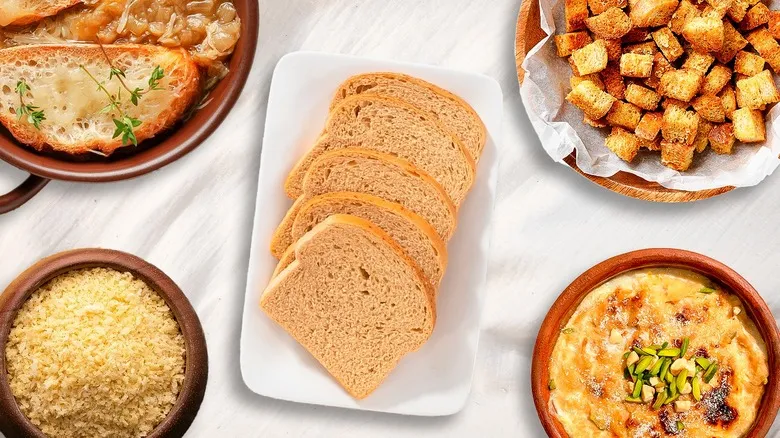Breadcrumbs
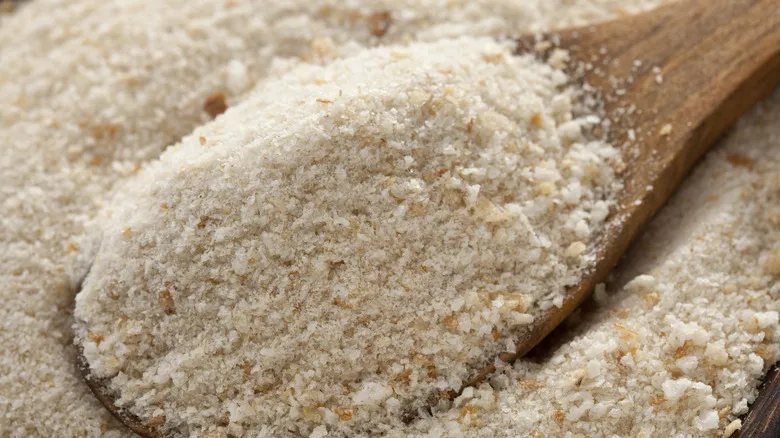
You can use various types of bread, whether in loaf or baguette form, to make breadcrumbs. Stale bread is the easiest to handle, as it becomes hard enough to cut while still being manageable. The simplest method for creating breadcrumbs from stale bread is to cut or break it into small cubes. Fill your food processor just under halfway with these cubes, then process them until they turn into crumbs. Once done, empty the container and repeat the process with another batch. After all the bread has been crumbled, spread the crumbs on a baking sheet and bake them for about 10 minutes at 350°F, stirring after 5 minutes.
While this is the most straightforward method for making breadcrumbs, there are alternative techniques. For example, if you don’t have a food processor or if the bread is too hard to cube, you can use a grater. Regardless of how you prepare your stale bread, you can either mix in dry seasonings with the breadcrumbs or keep them plain. There are differing opinions on the shelf life of homemade breadcrumbs. Most chefs agree that they can be stored for a few days in a sealed container on your countertop. After that, it’s best to refrigerate or freeze them. In the fridge, homemade breadcrumbs can last about a week, possibly longer, and when frozen, they can remain good for several months.
Croutons

There's nothing more disappointing than realizing that the crusty baguette you purchased just a day or two ago has turned into a hard rock. But as the saying goes, "When life hands you a tough baguette, turn it into croutons!" You can transform nearly any type of stale bread into croutons, and the process will feel familiar if you've made breadcrumbs before. Start by cutting the stale bread into cubes, roughly the same size as the croutons you find in stores. Some prefer to get creative and simply tear the bread into chunks of a similar size, which works just as well.
Once you've prepared the bread, the next step is to season your soon-to-be croutons. My go-to seasoning is a straightforward mix of garlic powder and salt, but feel free to experiment with any herbs or spices you enjoy. One essential ingredient you'll need is olive oil or butter. Combine the oil or melted butter with your chosen seasonings in a large bowl, then add the bread cubes (or pieces). Toss everything together until the bread is well-coated in the oil or butter and seasoning blend. After that, place them in the oven for about 15 minutes, and voilà! You'll have tasty, homemade croutons. To keep them fresh for up to a week or two, store them in a sealed container. That gives you plenty of time to savor them in salads and soups, or even as a delightful snack on their own.
French onion soup
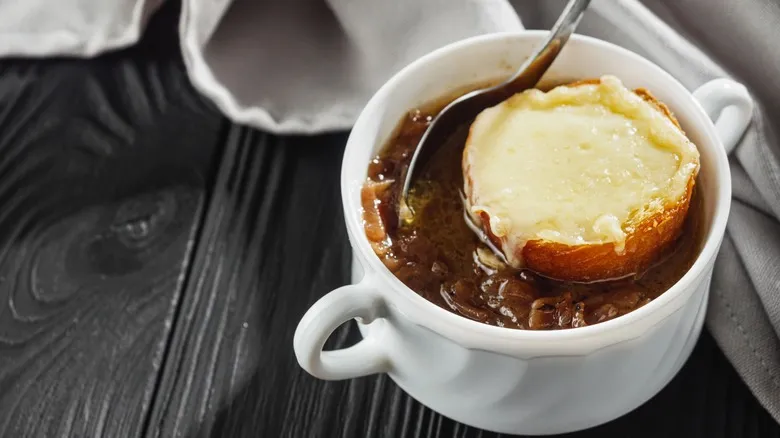
French cuisine is often perceived as elaborate and intricate, so you might be surprised to discover that traditional French onion soup is made with stale bread. This dish has a long history, dating back centuries, and has become a staple at traditional French weddings, which often last into the early morning hours. As dawn breaks and guests begin to feel hungry after the substantial meal they enjoyed the night before, French onion soup is typically served.
There are numerous variations of French onion soup, but the most popular method today involves sautéing onions in butter or oil, followed by adding bouillon (usually beef) to the caramelized onions. Many chefs also incorporate a splash of white wine or other spirits for added depth of flavor. The savory mixture is then topped with either croutons or whole pieces of hard or toasted bread, often finished with melted cheese. While various cheeses can be used, gruyère (similar to Swiss) and Comté are the most frequently chosen options. Stale bread is ideal for this delightful soup, as it needs to be firm. The hot soup and melted cheese will eventually soften it, but if you prefer smaller bites of bread, homemade croutons (a great way to utilize stale bread) are a fantastic alternative.
Bread pudding

One of the most popular uses for stale bread is to create bread pudding, a dish found in various cultures around the world. Due to regional and family traditions, there are significant differences in flavors and available ingredients, resulting in countless variations of bread pudding. However, the version you might be familiar with typically includes stale bread, custard, sugar, cinnamon, and possibly raisins. This dish has its origins in medieval Europe, particularly in England, where it has remained a beloved favorite over the centuries.
If you’ve never attempted to make bread pudding, it might seem intimidating, especially since many recipes call for preparing your own custard. This process can be portrayed as a delicate art, but there are also simpler methods shared by fellow home cooks. For example, while traditional custard involves blending eggs with hot milk or cream and other ingredients, some recipes suggest adding the eggs and other components directly to warmed milk and butter. Additionally, you’ll find recipes that skip custard altogether, opting for unexpected alternatives like ice cream.
Like many time-honored recipes, bread pudding encourages creativity. This applies not only to the custard but also to the addition of various dried fruits and spices beyond the usual cinnamon. Even the main ingredient, bread, can be any type you prefer. Whether you choose to stick with classic methods or venture into something entirely unique, you’re likely to end up with a delicious result.
Pappa al pomodoro
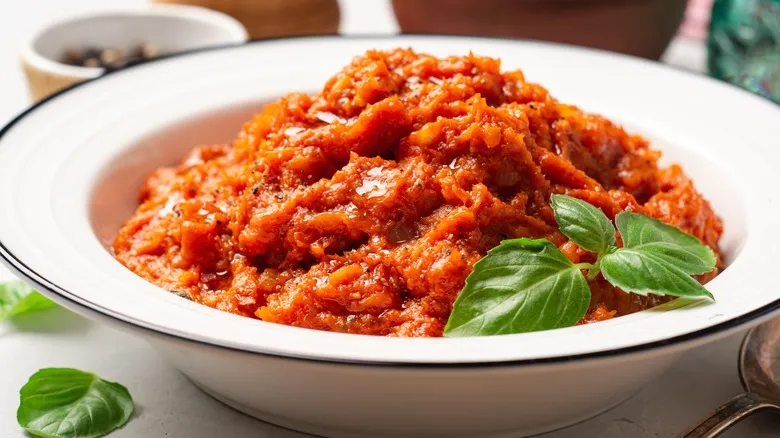
As enjoyable to pronounce as it is to savor, pappa al pomodoro is a classic Tuscan soup that highlights tomatoes and stale bread as its primary components. You might be thinking that this dish is simply a way to utilize leftover bread, but it’s actually a distinctive and flavorful option that is budget-friendly to prepare. While some variations may call for canned or pureed tomatoes, the best version of pappa al pomodoro is made with fresh tomatoes, as high-quality ingredients are fundamental to Italian cooking.
Regardless of your choice, the tomatoes can be used whole, chopped, or even pureed. They are then sautéed in hot olive oil and garlic (with some recipes adding onions) until they become tender. Next, seasonings—especially basil—are incorporated along with the stale bread. The term "pappa" translates to "mush" or "baby food" in Italian, indicating that the soup should have a soft consistency. This also means you should avoid using stale bread that is overly hard. On a positive note, pappa al pomodoro can be enjoyed hot, at room temperature, or even chilled.
Ribollita
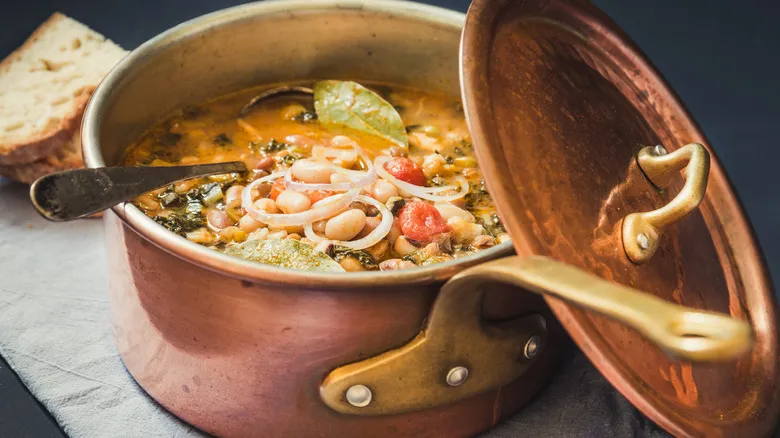
Ribollita is a robust vegetable soup that features stale bread as a key ingredient, making it a beloved Tuscan comfort dish, particularly on chilly days. This soup has practical roots: people would repurpose leftover vegetable soup by adding stale bread, resulting in a hearty and satisfying meal. While there are various interpretations of ribollita, most traditional recipes typically include ingredients such as carrots, onions, olive oil, garlic, and tomatoes (either fresh or canned, depending on the cook), along with the main attractions: cannellini beans and chunks of stale bread.
To prepare ribollita, start by slicing an onion and sautéing it in olive oil for a minute or two. Then, add the firmer vegetables and stir them in the oil until they soften. After that, incorporate broth (usually vegetable broth), beans, and other softer ingredients, along with the stale bread pieces. The bread can be quite hard or a bit softer, based on your preference. Ideally, an Italian loaf is recommended, but feel free to use whatever you have on hand. Some recipes may also suggest adding slices of sausage or grated cheese (my personal favorite is Pecorino Romano, though Parmesan is also a common choice). Traditionalists might insist on including kale—preferably black kale—but ultimately, it’s up to you!
Meatloaf

While variations of meatloaf have existed for thousands of years, the dish as we recognize it gained traction in the United States during the 1930s and 1940s. This period was marked by economic difficulties and rationing, making it an ideal way for cooks to make the most of limited meat supplies. Since then, meatloaf has become a beloved American staple. Nowadays, there are numerous adaptations of this loaf-shaped combination of ground meat or meats, chopped vegetables, and seasonings, and many meatloaf recipes also serve as an excellent way to utilize stale bread. Several recipes call for breadcrumbs or even whole slices of bread.
The inclusion of bread, in any form, helps keep the meatloaf mixture intact and prevents it from crumbling. Additionally, it absorbs moisture, ensuring that your meatloaf remains juicy. Since it’s incorporated into the mixture, the bread doesn’t need to be fresh. So, if you have some stale but still soft bread (or homemade breadcrumbs) on hand, feel free to add it in!
Panzanella
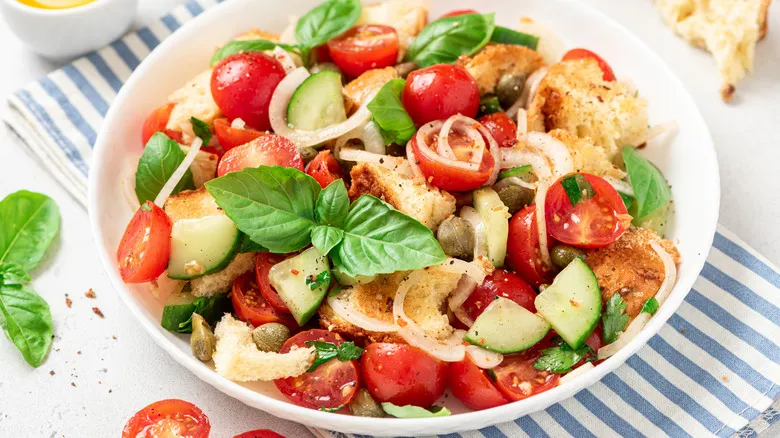
When discussing traditional Tuscan cuisine (or, more broadly, central Italian fare), stale bread serves a purpose beyond just soup. Panzanella takes a unique approach by transforming stale bread into a vibrant salad. The essential components of panzanella include stale bread, tomatoes, and vinaigrette. While many recipes offer creative vinaigrette variations, the classic version features a straightforward yet delightful mix of olive oil and red wine vinegar. Most recipes also incorporate sliced onions, and cucumber is a common addition as well.
That said, feel free to experiment with any ingredients that appeal to you, such as fresh green beans. When it comes to the bread, think of it as "croutons." If your stale bread is quite hard, you can break or cut it into small pieces to blend into the panzanella. If it’s still somewhat soft, slice it, drizzle with olive oil, and pop it in the oven for a short time to crisp it up. Once all your panzanella ingredients are prepared, combine them in a bowl and toss with the vinaigrette — and it’s ready to enjoy!
Shish kebabs and other skewer recipes

Shish kebabs are a traditional Mediterranean dish made with skewered vegetables and seasoned meat. However, as anyone who has ever grilled skewers knows, the options are virtually endless. You might opt for a vegetarian version with just veggies, or mix various meats and vegetables to create exciting flavor combinations. You can even take inspiration from your favorite dishes and prepare them in skewer form. A common element in many skewer recipes is the inclusion of bread cubes placed between the vegetables and meats.
The type of bread you choose can differ, but ideally, it should be stale. While it shouldn't be rock-hard, it should be firm enough to hold its shape, as it will soften by soaking up the juices and flavors from the other ingredients during cooking. The bread will develop a crusty exterior while remaining soft inside, thanks to those absorbed juices. If you prefer a crunchier texture, you can brush the bread with oil and bake it briefly before adding it to the skewer. Additionally, you can create panzanella skewers using stale bread, grilling the ingredients over low heat for a short time to enhance their flavors.
Stuffing
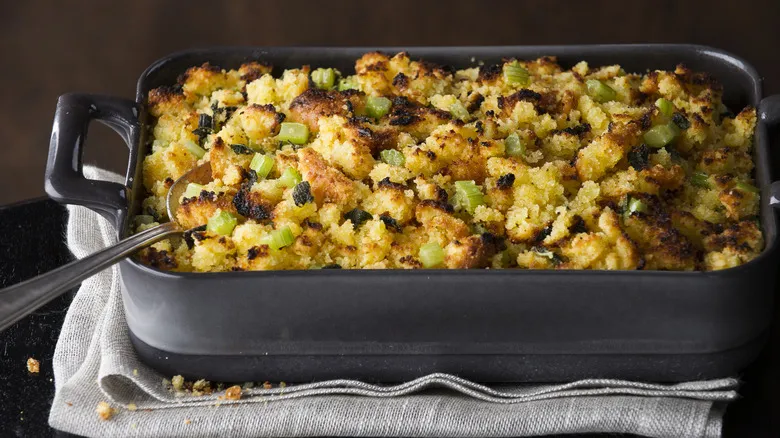
The roots of stuffing can be traced back to Ancient Mesopotamia and Rome, but today, most people connect it with festive holiday meals, particularly Thanksgiving dinner. There is a wide variety of stuffing recipes available, reflecting not only regional variations but also family traditions. Typically, bread plays a vital role in stuffing, providing a hearty component that helps achieve the ideal balance between being pleasantly moist and not overly soggy.
You can use various types of bread for stuffing, but it's important that the bread is relatively dry; otherwise, the stuffing may end up too mushy. Stale bread that is nearing hardness is ideal for this purpose. Some chefs even leave bread out for a few days to ensure it reaches the perfect level of staleness. When preparing the stuffing, you can cut the stale bread into cubes, or for a more textured result, tear it into smaller pieces by hand, which allows for better absorption of the flavors from the other stuffing ingredients. If you don’t have stale bread on hand, there’s no need to worry – you can simply cut or break fresh bread into pieces and place them in the oven at 300°F, turning them regularly until they reach the desired consistency.
Hachis parmentier topping

Hachis parmentier derives its name from the French word for chopped meat (hachis) and Antoine Augustin Parmentier, the 18th-century advocate who persuaded the French that potatoes were not only safe but also delicious. This dish is a beloved staple in French households. Often likened to cottage or shepherd's pie, hachis parmentier can vary significantly in the types of meat and seasonings used. However, its foundation consists of ground or shredded meat (typically beef) topped with creamy mashed potatoes. Some variations incorporate vegetables and spices into the meat mixture, while others feature a layer of melted cheese, usually gruyère, on top.
Many recipes for hachis parmentier finish off the delightful layers with breadcrumbs, adding a satisfying crunch that contrasts with the softer textures. Like many dishes on our list, hachis parmentier is relatively budget-friendly to prepare. It also boasts a long shelf life, remaining good for about five days in the refrigerator and several months in the freezer. When reheating, you might want to sprinkle on fresh breadcrumbs to maintain that crunchy texture, making this recipe a great way to use up any stale bread you have on hand.
Crostini
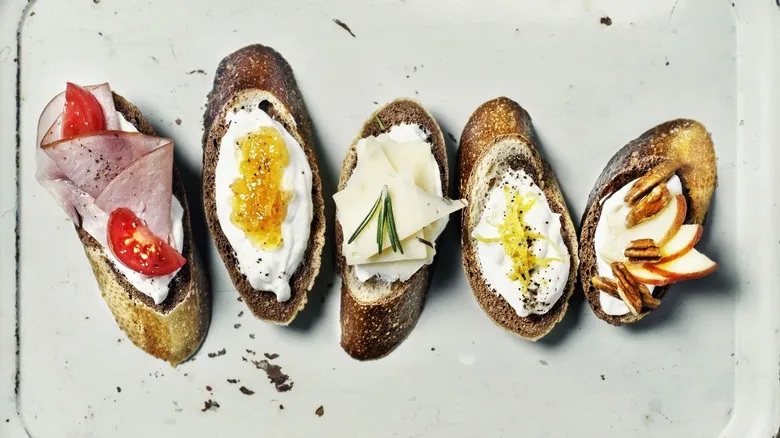
Do you have some small pieces of stale bread lying around and aren’t sure what to do with them? Why not whip up some crostini? This simple and tasty Italian appetizer, which translates to "little crusts," features small, relatively thin rounds of toasted bread that are brushed with olive oil and baked until crispy. Once they're ready, you can top them with any spread or topping you desire.
You might opt for a classic Italian topping like diced tomatoes mixed with olive oil, garlic, basil, and salt. This is the traditional topping for bruschetta, which is a close relative of crostini. While they share similarities, there are some important distinctions between the two. For instance, bruschetta is typically made with larger slices of bread, and it usually features a flavorful tomato topping, whereas crostini offers a wider variety of toppings. A quick online search will reveal an array of options and flavors from different cuisines around the globe. Whether you choose to make crostini, bruschetta, or even their Italian-American counterpart, garlic bread, stale bread is the perfect ingredient to use!
Italian-style meatballs
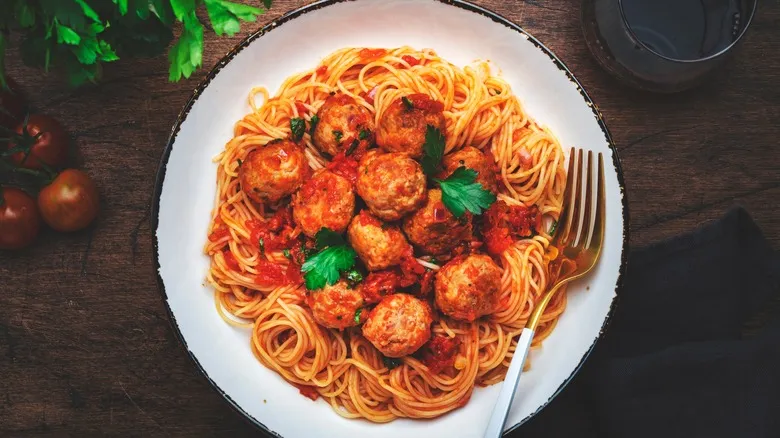
The name "meatballs" doesn't evoke thoughts of stale bread, but this beloved Italian-American dish often relies on breadcrumbs as a key component. This means that the breadcrumbs you created from your stale bread can enhance a delicious serving of spaghetti and meatballs.
Traditionally, the process of making meatballs involves mixing garlic powder, salt, breadcrumbs, seasonings, and an egg into ground meat (typically beef), shaping the mixture into balls, and then frying them. While the breadcrumbs shouldn't be noticeable in the final dish, they are crucial for keeping the meatballs moist. If you're preparing breadcrumbs specifically for meatballs, consider incorporating ingredients like garlic and herbs to blend seamlessly with the meat and other components. Just ensure your homemade breadcrumbs are relatively uniform and finely sized; otherwise, you might encounter larger chunks of bread when biting into a meatball. Allow your meatballs to simmer in tomato sauce (or "gravy," as we call it in North Jersey) for a bit before serving them with spaghetti or your favorite pasta.
Mozzarella sticks

Stale bread can be transformed into breadcrumbs, which opens the door to a variety of delicious snacks. One of my personal favorites is homemade mozzarella cheese sticks. After turning your stale bread into breadcrumbs, season them with your preferred spices (Italian seasonings are a popular choice). Next, slice dry mozzarella into finger-sized strips and coat each piece in egg, followed by flour, and then breadcrumbs. You can repeat this three-step coating process a couple of times to ensure a thick and crunchy exterior. Afterward, place your mozzarella sticks in the freezer for two hours to help the cheese hold its shape during cooking.
While many people choose to fry their mozzarella sticks, you can also use an air fryer or bake them in the oven. Once you’ve perfected the classic mozzarella stick, feel free to experiment with different seasonings in your breadcrumbs. You can even get creative by adding crushed potato chips or tortilla chips for an exciting twist.
Brown bread ice cream
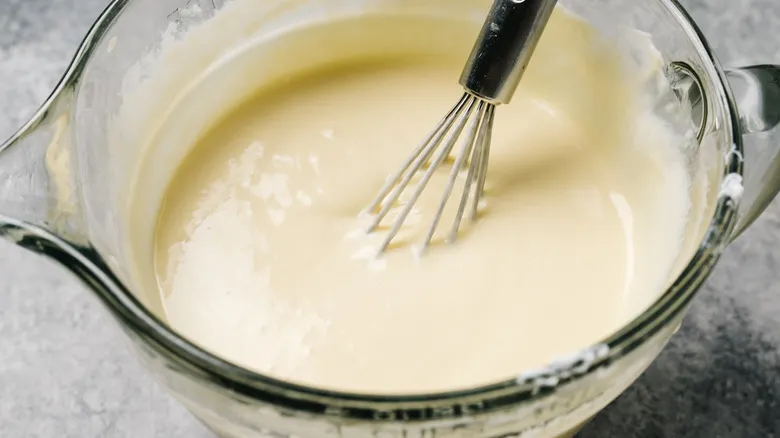
You may be well-acquainted with various ice cream flavors, but have you ever tried brown bread ice cream? This unique frozen treat has its roots in England and Ireland, where it continues to be enjoyed in many establishments today. There are several variations and levels of complexity when it comes to preparing brown bread ice cream, but the key to its delightful sweetness lies in one main ingredient: stale brown or wheat bread. Break a piece or two into small chunks, roughly the size of mini chocolate chips. Next, mix them with sugar and place them in the oven (some recipes recommend using brown sugar, while others opt for maple syrup).
After baking for about 10 minutes and allowing them to cool, you can incorporate the sweet crumbs into ice cream or custard. You can either whip up your own custard or make homemade ice cream, typically vanilla, for this delicious dessert. Alternatively, you can take a simpler approach by sprinkling your caramelized bread crumbs over store-bought ice cream or custard. We promise we won’t spill the secret!
Use stale bread as a household helper
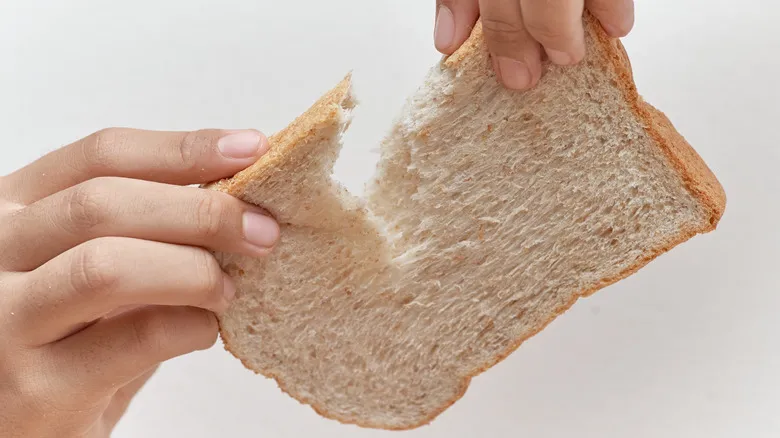
There are numerous ways to utilize stale bread, but did you realize it can also help solve various common household and cooking issues? For example, if your brown sugar has hardened, simply place a piece of stale (but still soft and not moldy) bread in the container. Seal it with the brown sugar for about a day, and the sugar will absorb moisture again. Once it has, you can remove the bread. If you still wish to use it afterward, it might be just right for making bread pudding!
Another fantastic use for stale bread around the house—especially for those of us who are a bit clumsy—is to pick up small shards of glass. After doing this, it's still wise to vacuum and remember to dispose of the bread. The benefits of stale bread don’t end there—if you see someone crumpling pieces and rubbing them on their walls, you might think they’ve lost their mind. In reality, they’re just well-informed. Slightly stale white bread is an effective, budget-friendly, and eco-friendly method for removing smudges and marks from walls. Before you grab a slice to try it out, consider wiping the dusty area of the wall with a cloth or lightly dampening any stubborn stains. Then, tear off a piece of bread, form it into a ball, and get to work.
Recommended

Alton Brown's Genius Box Fan Technique For Better Dried Herbs
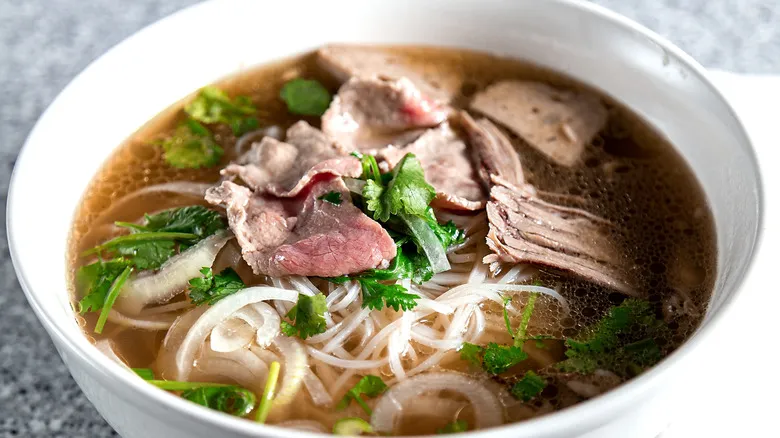
The Absolute Best Beef Cuts For Rich, Savory Pho
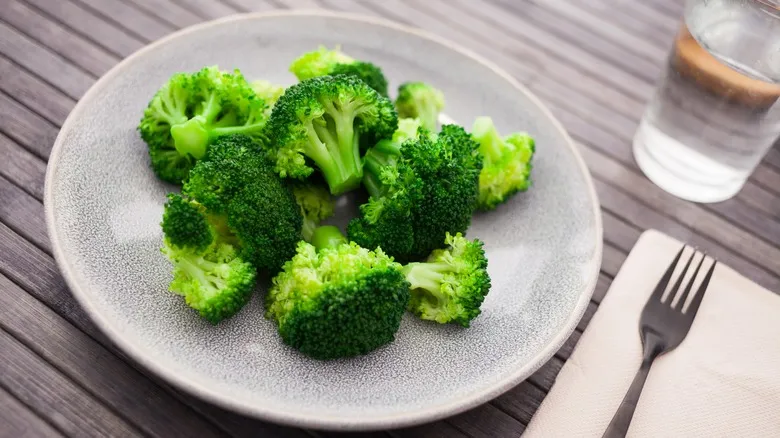
The Boiling Mistake That Causes Grey, Mushy Broccoli

The Right Way To Freeze And Thaw Leftover Hot Dog Buns
Next up

